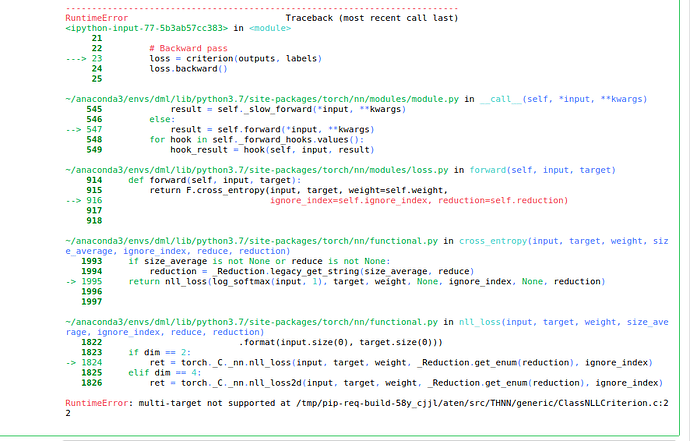Training set input size: torch.Size([19400, 1, 6, 100])
Training set labels size: torch.Size([19400, 5])
Test set input size: torch.Size([4851, 1, 6, 100])
Test set labels size: torch.Size([4851, 5])
Batch Size: 264
I am using a data loader to load this data to a neural network with an architecture as coded below:
class ConvUIL(nn.Module):
input_size = [6,100]
output_size = 5
input_channels = 1
channels_conv1 = 16
channels_conv2 = 48
kernel_conv1 = [1, 13]
kernel_conv2 = [1, 13]
pool_conv1 = [1, 2]
pool_conv2 = [1, 2]
channels_conv3 = 96
channels_conv4 = 128
channels_conv5 = 264
kernel_conv3 = [1, 11]
kernel_conv4 = [1, 3]
kernel_conv5 = [1, 3]
fcl1_size = 50
def __init__(self):
super(ConvUIL, self).__init__()
# Define the convolutional layers
self.conv1 = nn.Conv2d(self.input_channels, self.channels_conv1, self.kernel_conv1)
self.conv2 = nn.Conv2d(self.channels_conv1, self.channels_conv2, self.kernel_conv2)
self.conv3 = nn.Conv2d(self.channels_conv2, self.channels_conv3, self.kernel_conv3)
self.conv4 = nn.Conv2d(self.channels_conv3, self.channels_conv4, self.kernel_conv4)
self.conv5 = nn.Conv2d(self.channels_conv4, self.channels_conv5, self.kernel_conv5)
# Calculate the convolutional layers output size (stride = 1)
self.conv_out_size = int(264*6*2)
# Define the fully connected layers
self.fcl1 = nn.Linear(self.conv_out_size, self.fcl1_size)
self.fcl2 = nn.Linear(self.fcl1_size, self.output_size)
def forward(self, x):
# Apply convolution 1 and pooling
x = self.conv1(x)
x = F.relu(x)
x = F.max_pool2d(x, self.pool_conv1)
# Apply convolution 2 and pooling
x = self.conv2(x)
x = F.relu(x)
x = F.max_pool2d(x, self.pool_conv2)
# Apply convolution 3
x = self.conv3(x)
x = F.relu(x)
# Apply convolution 4
x = self.conv4(x)
x = F.relu(x)
# Apply convolution 5
x = self.conv5(x)
x = F.relu(x)
# Reshape x to one dimmension to use as input for the fully connected layers
x = x.view(-1, self.conv_out_size)
# Fully connected layers
x = self.fcl1(x)
x = F.relu(x)
x = self.fcl2(x)
return F.log_softmax(x, dim=1)
criterion = nn.NLLLoss()
optimizer = optim.Adam(model.parameters(), lr=0.01)
from torch.autograd import Variable
epochs = 20
for epoch in range(epochs):
loss = 0
correct = 0
total = wind_test_y.size(0)
# Train the model
for i, (observations, labels) in enumerate(train_dataset):
observations = Variable(observations)
labels = Variable(labels)
# Forward pass
optimizer.zero_grad()
outputs = convUIL(observations)
print(outputs)
print(labels)
# Backward pass
loss = criterion(outputs, labels)
loss.backward()
# Optimize
optimizer.step()
# Test the model on the validation data
for observations, labels in test_dataset:
observations = Variable(observations)
# Forward pass
outputs = convUIL(observations)
_, predicted = torch.max(outputs.data, 1)
correct = (predicted == labels).sum()
accuracy = correct / total
print('Epoch [%2d/%2d], Accuracy: %.4f' % (epoch + 1, epochs, accuracy))

